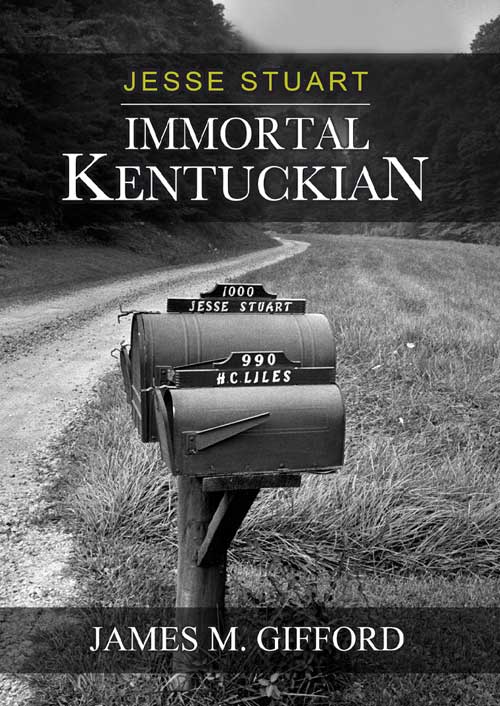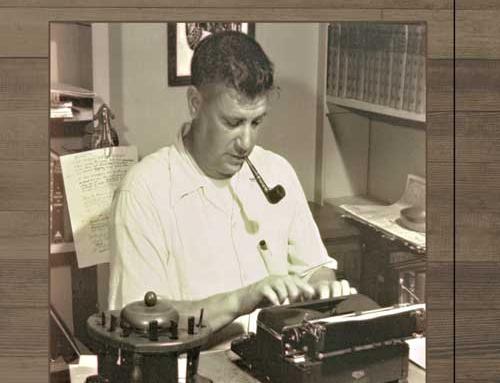World War II had been underway a little more than two years when Japan’s savage attack at Pearl Harbor, December 7, 1941, plunged America into the global conflict. Early the following year, Jesse Stuart, nearly 36 with a pregnant wife, tried to enlist in the army but failed the physical. Like millions of American men, he wanted to serve his country and defend his family and his freedoms.
 Two years later, Jesse tried to enter the war again by joining the Navy. This time, he passed his physical exam in Huntington, West Virginia, in February, and was sworn in at Louisville on March 31, 1944. He left immediately for basic training at the Great Lakes Training Command near Chicago and was there for fourteen weeks, missing his family, and their “little home, dogs and chickens.”
Two years later, Jesse tried to enter the war again by joining the Navy. This time, he passed his physical exam in Huntington, West Virginia, in February, and was sworn in at Louisville on March 31, 1944. He left immediately for basic training at the Great Lakes Training Command near Chicago and was there for fourteen weeks, missing his family, and their “little home, dogs and chickens.”
On July 12, 1944, a month before his thirty-eighth birthday, he graduated and was commissioned as a lieutenant (j.g.). He was assigned to the Bureau of Aeronautics in Washington, D.C., where he worked until the war ended. In the Writers Unit, he was given weak assignments that did not stimulate his cyclonic energy.
Jesse was conflicted over his role in the war. He felt guilty because of the “easy life” he and his co-workers were living in Washington and wondered if he could have been more useful as a farmer than as a bureaucrat in uniform. Meanwhile, his younger brother, James, was in the Leyte, Luzon, and Okinawa invasions.
As with most American families, World War II was a family affair for the Stuarts. While Jesse and James joined two million fellow southerners in uniform, their three sisters worked at the Clayton Lambert munitions plant in Wurtland (Greenup County) during the war. Sophia, Mary, and Glennis were part of a generation of American women who proved that “the woman’s place” was not necessarily in the home.
In the national workplace, women replaced men who were serving during World War II and women also, for the first time in American history, served in non-combat jobs in the armed services. More than 250,000 women served as Wacs (Army), Spars (Coast Guard), Waves (Navy), and in the Marine Corps. The “girls behind the men behind the guns” were machinists, storekeepers, clerical workers, and radio operators, and they drove jeeps and trucks and flew airplanes in non-combat roles. During the 1940s, they played an active role in winning a two-front war that spanned the entire globe.
World War II officially ended on September 2, 1945, and Jesse Stuart was mustered out of the Navy on December 31, 1945. He and his family left Washington “in a hurry” to get home. They departed at noon in poor driving conditions and drove seven and a half hours to Clarksburg, West Virginia, a distance of almost 250 miles. The next day they weathered a “blinding snowstorm and icy roads” to Ohio, where conditions improved for the remainder of the trip. They stayed in Greenup with his wife’s parents for two days, waiting for the ground to freeze so they could drive the rutted dirt roads into their beloved W-Hollow.
More than a decade later, he observed that for “one year after I got out of the service all I wrote should have been burned. What was wrong? You tell me. I don’t know.”
Similarly, after World War II, the great Kentucky writer James Still sat “for months … in the door of [his] log house and could not arouse interest in things [he] had done before.” He eventually began to write again, but his pace was slower, more deliberate–all in all, less enthusiastic. The war had left him a “changed man.” Jesse suffered the same postwar malaise, complaining in 1946 that he didn’t “have any book coming out or any ideas.”
Stuart, Still, and millions of other soldiers suffered a postwar depression due to emotional and physical exhaustion. At another level that was probably not articulated and perhaps not understood, this generation of soldiers was conflicted by the fact they had helped to liberate oppressed people around the globe, but they returned home to a nation that, for the most part, reflected the same racism and sexism that had prevailed before World War II.
For more information about the Stuarts during and after WWII, see “Jesse Stuart: Immortal Kentuckian,” available at the Jesse Stuart Foundation, 4440 13th Street in Ashland. For more information call 606-326-1667 or email jsf@jsfbooks.com.
By James M. Gifford
JSF CEO & Senior Editor
World War II had been underway a little more than two years when Japan’s savage attack at Pearl Harbor, December 7, 1941, plunged America into the global conflict. Early the following year, Jesse Stuart, nearly 36 with a pregnant wife, tried to enlist in the army but failed the physical. Like millions of American men, he wanted to serve his country and defend his family and his freedoms.
Two years later, Jesse tried to enter the war again by joining the Navy. This time, he passed his physical exam in Huntington, West Virginia, in February, and was sworn in at Louisville on March 31, 1944. He left immediately for basic training at the Great Lakes Training Command near Chicago and was there for fourteen weeks, missing his family, and their “little home, dogs and chickens.”
On July 12, 1944, a month before his thirty-eighth birthday, he graduated and was commissioned as a lieutenant (j.g.). He was assigned to the Bureau of Aeronautics in Washington, D.C., where he worked until the war ended. In the Writers Unit, he was given weak assignments that did not stimulate his cyclonic energy.

Jesse was conflicted over his role in the war. He felt guilty because of the “easy life” he and his co-workers were living in Washington and wondered if he could have been more useful as a farmer than as a bureaucrat in uniform. Meanwhile, his younger brother, James, was in the Leyte, Luzon, and Okinawa invasions.
As with most American families, World War II was a family affair for the Stuarts. While Jesse and James joined two million fellow southerners in uniform, their three sisters worked at the Clayton Lambert munitions plant in Wurtland (Greenup County) during the war. Sophia, Mary, and Glennis were part of a generation of American women who proved that “the woman’s place” was not necessarily in the home.
In the national workplace, women replaced men who were serving during World War II and women also, for the first time in American history, served in non-combat jobs in the armed services. More than 250,000 women served as Wacs (Army), Spars (Coast Guard), Waves (Navy), and in the Marine Corps. The “girls behind the men behind the guns” were machinists, storekeepers, clerical workers, and radio operators, and they drove jeeps and trucks and flew airplanes in non-combat roles. During the 1940s, they played an active role in winning a two-front war that spanned the entire globe.
World War II officially ended on September 2, 1945, and Jesse Stuart was mustered out of the Navy on December 31, 1945. He and his family left Washington “in a hurry” to get home. They departed at noon in poor driving conditions and drove seven and a half hours to Clarksburg, West Virginia, a distance of almost 250 miles. The next day they weathered a “blinding snowstorm and icy roads” to Ohio, where conditions improved for the remainder of the trip. They stayed in Greenup with his wife’s parents for two days, waiting for the ground to freeze so they could drive the rutted dirt roads into their beloved W-Hollow.
More than a decade later, he observed that for “one year after I got out of the service all I wrote should have been burned. What was wrong? You tell me. I don’t know.”
Similarly, after World War II, the great Kentucky writer James Still sat “for months … in the door of [his] log house and could not arouse interest in things [he] had done before.” He eventually began to write again, but his pace was slower, more deliberate–all in all, less enthusiastic. The war had left him a “changed man.” Jesse suffered the same postwar malaise, complaining in 1946 that he didn’t “have any book coming out or any ideas.”
Stuart, Still, and millions of other soldiers suffered a postwar depression due to emotional and physical exhaustion. At another level that was probably not articulated and perhaps not understood, this generation of soldiers was conflicted by the fact they had helped to liberate oppressed people around the globe, but they returned home to a nation that, for the most part, reflected the same racism and sexism that had prevailed before World War II.
For more information about the Stuarts during and after WWII, see “Jesse Stuart: Immortal Kentuckian,” available at the Jesse Stuart Foundation, 4440 13th Street in Ashland. For more information call 606-326-1667 or email jsf@jsfbooks.com.
By James M. Gifford
JSF CEO & Senior Editor



